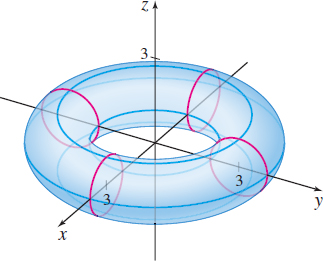EXAMPLE 2Describing a Parametric Surface
Describe the parametric surface S parametrized by r(u,v)=(3+cosv)cosui+(3+cosv)sinuj+sinvk
where 0≤u≤2π and 0≤v≤2π.
Solution We begin by finding some u-coordinate curves. Since the parametrization involves trigonometric functions, we choose 0,π2,π, and 3π2. Then the u-coordinate curves are r(u,0)=4cosui+4sinujr(u,π2)=3cosui+3sinuj+kr(u,π)=2cosui+2sinujr(u,3π2)=3cosui+3sinuj−k
We identify the graphs of each of these curves by using parametric equations. For example, for r(u,0), we have x=4cosu, y=4sinu, and x2+y2=(4cosu)2+(4sinu)2=42(cos2u+sin2u)=42

a circle of radius 4 centered at the origin. Similarly, r=r(u,π) is a circle of radius 2 centered at the origin. The graphs of r(u,π2) and r(u,3π2) are both circles of radius 3, but the center of r=r(u,π2) is at (0,0,1) and the center of r=r(u,3π2) is at (0,0,−1). Do you see why? See the blue circles in Figure 42.
Using 0,π2,π, and 3π2 for u, we obtain the v-coordinate curves: r(0,v)=(3+cosv)i+sinvkr(π2,v)=(3+cosv)j+sinvkr(π,v)=−(3+cosv)i+sinvkr(3π2,v)=−(3+cosv)j+sinvk
Again, we identify the graphs of these curves as circles. Each graph is a circle of radius 1, but the centers of the circles r=r(0,v), r=r(π,v), r=r(π2,v), and r=r(3π2,v) are (3,0,0), (−3,0,0), (0,3,0), and (0,−3,0), respectively. See the red circles in Figure 42.
The surface S is a torus. This particular torus results from revolving a circle of radius 1 about a circle of radius 3 centered at the origin.